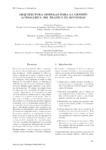Arquitectura modular para la gestión automática del tráfico en rotondas

Use this link to cite
http://hdl.handle.net/2183/28373
Except where otherwise noted, this item's license is described as Atribución-NoComercial-CompartirIgual 4.0 Internacional
https://creativecommons.org/licenses/by-nc-sa/4.0/deed.es
Collections
Metadata
Show full item recordTitle
Arquitectura modular para la gestión automática del tráfico en rotondasAlternative Title(s)
Intelligent control in the edge of the fog: automatic traffic management in roundaboutsAuthor(s)
Date
2021Citation
Lara-Domínguez, A., Uribe-Chavert, P., Poza-Luján, J.L., Posadas-Yagüe, J.L. Arquitectura modular para la gestión automática del tráfico en rotondas. En XLII Jornadas de Automática: libro de actas. Castelló, 1-3 de septiembre de 2021 (pp. 731-738). DOI capítulo: https://doi.org/10.17979/spudc.9788497498043.731 DOI libro: https://doi.org/10.17979/spudc.9788497498043
Abstract
[Resumen] En los entornos de movilidad, calles o carreteras, los cruces y las rotondas pueden generar problemas de atascos. Poder optimizar el tráfico entrante
y saliente de un cruce o rotonda es uno de los campos de investigación de los sistemas de control inteligente. Para optimizar el tráfico se debe
disponer de dispositivos capaces de detectar los vehículos así como de actuar, regulando el tráfico, de forma dinámica para adaptarse a las distintas circunstancias. El sistema presentado busca la adaptación a las necesidades de tráfico en una rotonda. Dependiendo de la saturación de cada
carril de entrada se intenta crear un tráfico fluido y continuo en el interior de la misma. Para lograr mejorar el tráfico, en este trabajo se presenta
una arquitectura modular que permite adaptarse a cualquier cruce o rotonda para, a partir del control específico de un sector, mejorar el rendimiento global. El sistema simulado está compuesto por dispositivos independientes, que, dependiendo de la información adquirida varían el tiempo de paso. Se presenta, asimismo, un experimento de simulaci ón en el que se pone en valor la capacidad de reducir el tráfico adaptando los tiempos de paso en función de la demanda. Los resultados muestran que es posible descongestionar una rotonda cuando se automatizan dinámicamente los tiempos de paso sobre los que se tiene control. [Abstract] Crossroads and roundabouts, can produce traffic jams if traffic management is not optimized. To manage these elements, it is necessary to have devices able to detect the level of traffic as well as to act dynamically in order to adapt the cross access time in each street. The system seeks to adapt to the traffic needs in the roundabout, depending on the saturation of each entrance lane, trying to create a fluid and continuous traffic inside it. In order to optimize the traffic, in this work, a simulation experiment is presented in which the ability to reduce traffic is valued by adapting the access times to a roundabout according to the traffic demand. The simulated system is composed of independent devices, which, depending on the information acquired, can change the access time to the roundabout. The results show that it is possible to reduce the traffic load in a roundabout when access times are dynamically automated.
Keywords
Control inteligente
Control distribuido
Gestión del tráfico
Ciudades inteligentes
Intelligent control
Distributed control
Traffic management
Smart cities
Control distribuido
Gestión del tráfico
Ciudades inteligentes
Intelligent control
Distributed control
Traffic management
Smart cities
Editor version
Rights
Atribución-NoComercial-CompartirIgual 4.0 Internacional
https://creativecommons.org/licenses/by-nc-sa/4.0/deed.es
ISBN
978-84-9749-804-3






